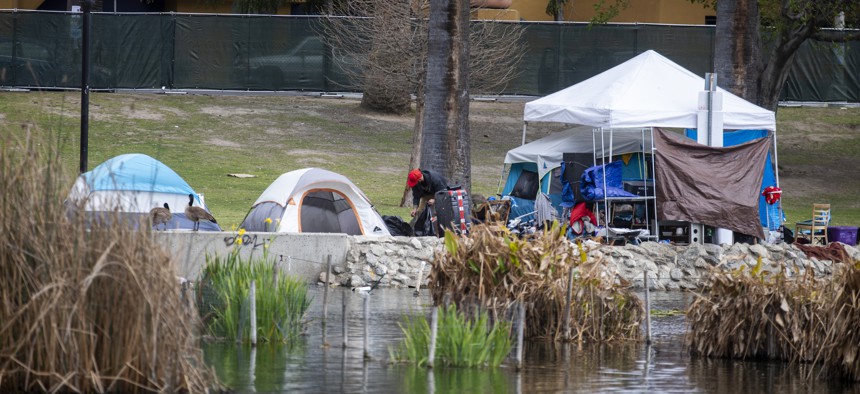Homelessness is increasing nationwide, but some cities see significant declines

People experiencing homelessness pack up their belongings in a Los Angeles park. Francine Orr / Los Angeles Times via Getty Images
Many believe they are seeing more people experiencing homelessness than ever before. But in three major cities, the data contradicts that perception.
If you’ve recently walked through a major downtown and felt there were more people experiencing homelessness than ever before, you’re not alone. But what you saw may be deceiving, according to a new study.
A report from the Brookings Institution shows that while many people believe that homelessness has rapidly risen over the last several years, it has actually declined by 42% in Chicago, 25% in Philadelphia and 16% in New York in the last decade. Seattle, the fourth city included in the study, was an outlier—overall homelessness in the Emerald City increased by 25%.
The perception that homelessness is increasing isn’t entirely unfounded. Some communities are indeed seeing increasing rates, particularly in western states.
But there’s been a decline in some of the country’s largest cities, which may come as a surprise to many. In a survey last year, Brookings researchers asked 100 workers, residents and visitors in the four cities what prevented them from spending time downtown, and one of the most common answers was their fear of increased crime and homelessness, more than their shifts to remote work.
“There are more homeless people in more places now than there were pre-pandemic. I would say that's true of every city I've been in,” said one respondent in Chicago. “Homelessness wasn't even like this during the crack cocaine ‘80s,” said another of Philadelphia. “It is terrible.”
The pandemic-induced shifts in downtown foot traffic is likely driving the public’s perception of increased homelessness, according to report co-author Tracy Loh. When visitors, workers and shoppers stopped going downtown during the pandemic, people experiencing homelessness began spending more time in places that were previously too busy to be attractive places to rest. Now, as people start returning to those areas, they're seeing unsheltered people in places they previously weren’t, she said. And with fewer workers and visitors downtown today, the share of unhoused people is greater than before the pandemic, even if there wasn’t a net increase.
“The visibility of the homeless population, that's what went up,” Loh said, “not the actual population in terms of absolute numbers in most cases.”
In Chicago, New York and Philadelphia, unsheltered homelessness has remained steady over much of the last decade. Unsheltered homelessness accounts for only up to one-third of homelessness in most cities, the report notes. But because it is so visible to the public and dangerous for those experiencing it, the issue captures a significant share of city resources and often garners the most media attention.
It’s important to note the prevalence of unsheltered homelessness varies widely across regions. In several West Coast cities, more than half of homeless populations are unsheltered.
Sheltered homelessness, meanwhile, includes people staying in shelters or transitional housing, and makes up the vast majority of many cities’ homeless populations. In New York, for instance, 94% of people experiencing homelessness are in shelters. These nuances in urban homelessness “can hold significant and often underappreciated ramifications for local policymaking,” the report said.
The mismatch between perception and reality is worrisome, Loh said. It can push the public to think that the worthwhile strategies many cities are employing—including housing-first policies or programs that support people leaving incarceration—aren’t working. That, in turn, can lead the public to believe other measures like criminalizing homelessness could be more effective.
The report is based on data from the census and the U.S. Department of Housing and Urban Development’s housing inventory and its point-in-time count, which annually records the number of people experiencing homelessness on a single night in January. So while the report is encouraging for some cities, Loh noted that the data is limited and fails to capture periodic or seasonal fluctuations in homelessness, such as the increase in migrants arriving in cities like New York and Chicago.
That means communities looking to more accurately assess their homelessness challenges must collect additional data more frequently, Loh said, adding that those making the best progress in addressing homelessness are the ones that go beyond local point-in-time counts and collect live data year-round.
“Becoming more data driven is a big piece of how to get better at doing something about homelessness,” Loh said. “When you have better data, you can make better decisions and then you can also do performance management of your response.”
NEXT STORY: How to make skills-based hiring work






